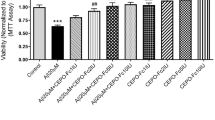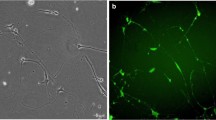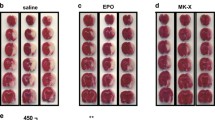Abstract
Epilepsy is among the most common neurological disorders. Recurrent seizures result in neuronal death, cognitive deficits and intellectual disabilities in children. Currently, recombinant human erythropoietin (rhEPO) is considered to play a neuroprotective role in nervous system disorders. However, the precise mechanisms through which rhEPO modulates epilepsy remain unknown. Based on results from numerous studies, we hypothesized that rhEPO protects against hippocampal damage in developing rats with seizures probably by modulating autophagy via the ribosomal protein S6 (S6) in a time-dependent manner. First, we observed that rats with recurrent seizures displayed neuronal loss in the hippocampal CA1 region. Second, rhEPO injection reduced neuronal loss and decreased the number of apoptotic cells in the hippocampal CA1 region. Moreover, rhEPO increased the Bcl-2 protein expression levels and decreased the ratio of cleaved caspase-3/caspase-3 in the hippocampus. Finally, rhEPO modulated autophagy in the hippocampus in a time-dependent manner, probably via the S6 protein. In summary, rhEPO protects against hippocampal damage in developing rats with seizures by modulating autophagy in a time-dependent manner, probably via the S6 protein. Consequently, rhEPO is a likely drug candidate that is capable of attenuating brain injury.








Similar content being viewed by others
References
Fiest KM, Sauro KM, Wiebe S, Patten SB, Kwon CS, Dykeman J, Pringsheim T, Lorenzetti DL, Jetté N (2017) Prevalence and incidence of epilepsy: a systematic review and meta-analysis of international studies. Neurology 88:296–303. https://doi.org/10.1212/WNL.0000000000003509
Jackson CF, Makin SM, Marson AG, Kerr M (2015) Pharmacological interventions for epilepsy in people with intellectual disabilities. Cochrane Database Syst Rev (9):D5399. https://doi.org/10.1002/14651858.CD005399.pub3
Tellez-Zenteno JF, Patten SB, Jetté N, Williams J, Wiebe S (2007) Psychiatric comorbidity in epilepsy: a population-based analysis. Epilepsia 48:2336–2344. https://doi.org/10.1111/j.1528-1167.2007.01222.x
Covanis A, Guekht A, Li S, Secco M, Shakir R, Perucca E (2015) From global campaign to global commitment: the World Health Assembly’s Resolution on epilepsy. Epilepsia 56:1651–1657. https://doi.org/10.1111/epi.13192
Sasaki R, Masuda S, Nagao M (2001) Pleiotropic functions and tissue-specific expression of erythropoietin. News Physiol Sci 16:110–113
Juul SE, Anderson DK, Li Y, Christensen RD (1998) Erythropoietin and erythropoietin receptor in the developing human central nervous system. Pediatr Res 43:40–49. https://doi.org/10.1203/00006450-199804001-00243
Brines ML, Ghezzi P, Keenan S, Agnello D, de Lanerolle NC, Cerami C, Itri LM, Cerami A (2000) Erythropoietin crosses the blood-brain barrier to protect against experimental brain injury. Proc Natl Acad Sci USA 97:10526–10531. https://doi.org/10.1073/pnas.97.19.10526
Lan KM, Tien LT, Cai Z, Lin S, Pang Y, Tanaka S, Rhodes PG, Bhatt AJ, Savich RD, Fan LW (2016) Erythropoietin ameliorates neonatal hypoxia-ischemia-induced neurobehavioral deficits, neuroinflammation, and hippocampal injury in the juvenile rat. Int J Mol Sci 17:289. https://doi.org/10.3390/ijms17030289
Jang W, Kim HJ, Li H, Jo KD, Lee MK, Yang HO (2016) The neuroprotective effect of erythropoietin on rotenone-induced neurotoxicity in SH-SY5Y cells through the induction of autophagy. Mol Neurobiol 53:3812–3821. https://doi.org/10.1007/s12035-015-9316-x
Hou W, Han J, Lu C, Goldstein LA, Rabinowich H (2010) Autophagic degradation of active caspase-8: a crosstalk mechanism between autophagy and apoptosis. Autophagy 6:891–900. https://doi.org/10.4161/auto.6.7.13038
Bockaert J, Marin P (2015) mTOR in brain physiology and pathologies. Physiol Rev 95:1157–1187. https://doi.org/10.1152/physrev.00038.2014
Biever A, Valjent E, Puighermanal E (2015) Ribosomal protein S6 phosphorylation in the nervous system: from regulation to function. Front Mol Neurosci 8:75. https://doi.org/10.3389/fnmol.2015.00075
Tanemura M, Ohmura Y, Deguchi T, Machida T, Tsukamoto R, Wada H, Kobayashi S, Marubashi S, Eguchi H, Ito T, Nagano H, Mori M, Doki Y (2012) Rapamycin causes upregulation of autophagy and impairs islets function both in vitro and in vivo. Am J Transplant 12:102–114. https://doi.org/10.1111/j.1600-6143.2011.03771.x
Crino PB (2016) The mTOR signalling cascade: paving new roads to cure neurological disease. Nat Rev Neurol 12:379–392. https://doi.org/10.1038/nrneurol.2016.81
Blommaart EF, Luiken JJ, Blommaart PJ, van Woerkom GM, Meijer AJ (1995) Phosphorylation of ribosomal protein S6 is inhibitory for autophagy in isolated rat hepatocytes. J Biol Chem 270:2320–2326. https://doi.org/10.1074/jbc.270.5.2320
Kassai H, Sugaya Y, Noda S, Nakao K, Maeda T, Kano M, Aiba A (2014) Selective activation of mTORC1 signaling recapitulates microcephaly, tuberous sclerosis, and neurodegenerative diseases. Cell Rep 7:1626–1639. https://doi.org/10.1016/j.celrep.2014.04.048
Zeng LH, Rensing NR, Wong M (2009) The mammalian target of rapamycin signaling pathway mediates epileptogenesis in a model of temporal lobe epilepsy. J Neurosci 29:6964–6972. https://doi.org/10.1523/JNEUROSCI.0066-09.2009
Macias M, Blazejczyk M, Kazmierska P, Caban B, Skalecka A, Tarkowski B, Rodo A, Konopacki J, Jaworski J (2013) Spatiotemporal characterization of mTOR kinase activity following kainic acid induced status epilepticus and analysis of rat brain response to chronic rapamycin treatment. PLoS ONE 8:e64455. https://doi.org/10.1371/journal.pone.0064455
Jastrzebski K, Hannan KM, Tchoubrieva EB, Hannan RD, Pearson RB (2007) Coordinate regulation of ribosome biogenesis and function by the ribosomal protein S6 kinase, a key mediator of mTOR function. Growth Factors 25:209–226. https://doi.org/10.1080/08977190701779101
Kurt AH, Bosnak M, Inan SY, Celik A, Uremis MM (2016) Epileptogenic effects of G protein-coupled estrogen receptor 1 in the rat pentylenetetrazole kindling model of epilepsy. Pharmacol Rep 68:66–70. https://doi.org/10.1016/j.pharep.2015.07.001
Nadam J, Navarro F, Sanchez P, Moulin C, Georges B, Laglaine A, Pequignot JM, Morales A, Ryvlin P, Bezin L (2007) Neuroprotective effects of erythropoietin in the rat hippocampus after pilocarpine-induced status epilepticus. Neurobiol Dis 25:412–426. https://doi.org/10.1016/j.nbd.2006.10.009
Racine RJ (1972) Modification of seizure activity by electrical stimulation. II. Motor seizure. Electroencephalogr Clin Neurophysiol 32:281–294. https://doi.org/10.1016/0013-4694(72)90177-0
Igarashi KM, Ito HT, Moser EI, Moser MB (2014) Functional diversity along the transverse axis of hippocampal area CA1. FEBS Lett 588:2470–2476. https://doi.org/10.1016/j.febslet.2014.06.004
Nishimura M, Gu X, Swann JW (2011) Seizures in early life suppress hippocampal dendrite growth while impairing spatial learning. Neurobiol Dis 44:205–214. https://doi.org/10.1016/j.nbd.2011.07.002
Casanova JR, Nishimura M, Owens JW, Swann JW (2012) Impact of seizures on developing dendrites: implications for intellectual developmental disabilities. Epilepsia 53(Suppl 1):116–124. https://doi.org/10.1111/j.1528-1167.2012.03482.x
Camfield PR, Camfield CS (2014) What occurs to children with epilepsy when they become adults? Some facts and opinions. Pediatr Neurol 51:17–23. https://doi.org/10.1016/j.pediatrneurol.2014.02.020
Sharma AK, Reams RY, Jordan WH, Miller MA, Thacker HL, Snyder PW (2007) Mesial temporal lobe epilepsy: pathogenesis, induced rodent models and lesions. Toxicol Pathol 35:984–999. https://doi.org/10.1080/01926230701748305
Buckmaster PS (2010) Mossy fiber sprouting in the dentate gyrus. Epilepsia 51:39–39. https://doi.org/10.1111/j.1528-1167.2010.02825.x
Zeng LH, Xu L, Gutmann DH, Wong M (2008) Rapamycin prevents epilepsy in a mouse model of tuberous sclerosis complex. Ann Neurol 63:444–453. https://doi.org/10.1002/ana.21331
Zhang B, Zou J, Han L, Rensing N, Wong M (2016) Microglial activation during epileptogenesis in a mouse model of tuberous sclerosis complex. Epilepsia 57:1317–1325. https://doi.org/10.1111/epi.13429
Héja L (2014) Astrocytic target mechanisms in epilepsy. Curr Med Chem 21:755–763. https://doi.org/10.2174/0929867320666131119160445
Kubová H, Mares P, Suchomelová L, Brozek G, Druga R, Pitkänen A (2004) Status epilepticus in immature rats leads to behavioral and cognitive impairment and epileptogenesis. Eur J Neurosci 19:3255–3265. https://doi.org/10.1111/j.0953-816X.2004.03410.x
Castro-Torres RD, Chaparro-Huerta V, Flores-Soto ME, Bañuelos-Pineda J, Camins A, Orozco-Suárez SA, Armendáriz-Borunda J, Beas-Zárate C (2014) A single dose of pirfenidone attenuates neuronal loss and reduces lipid peroxidation after kainic acid-induced excitotoxicity in the pubescent rat hippocampus. J Mol Neurosci 52:193–201. https://doi.org/10.1007/s12031-013-0121-6
Benz AP, Niquet J, Wasterlain CG, Rami A (2014) Status epilepticus in the immature rodent brain alters the dynamics of autophagy. Curr Neurovasc Res 11:125–135. https://doi.org/10.2174/1567202611666140305215009
Sun J, Xie C, Liu W, Lu D, Qiao W, Huang Q, Huo Z, Shen H, Lin Z (2012) The effects of simvastatin on hippocampal caspase-3 and Bcl-2 expression following kainate-induced seizures in rats. Int J Mol Med 30:739–746. https://doi.org/10.3892/ijmm.2012.1076
Drexel M, Preidt AP, Sperk G (2012) Sequel of spontaneous seizures after kainic acid-induced status epilepticus and associated neuropathological changes in the subiculum and entorhinal cortex. Neuropharmacology 63:806–817. https://doi.org/10.1016/j.neuropharm.2012.06.009
Lévesque M, Avoli M (2013) The kainic acid model of temporal lobe epilepsy. Neurosci Biobehav Rev 37:2887–2899. https://doi.org/10.1016/j.neubiorev.2013.10.011
Tooyama I, Bellier JP, Park M, Minnasch P, Uemura S, Hisano T, Iwami M, Aimi Y, Yasuhara O, Kimura H (2002) Morphologic study of neuronal death, glial activation, and progenitor cell division in the hippocampus of rat models of epilepsy. Epilepsia 43(Suppl 9):39–43. https://doi.org/10.1046/j.1528-1157.43.s.9.10.x
Marti HH, Wenger RH, Rivas LA, Straumann U, Digicaylioglu M, Henn V, Yonekawa Y, Bauer C, Gassmann M (1996) Erythropoietin gene expression in human, monkey and murine brain. Eur J Neurosci 8:666–676. https://doi.org/10.1111/j.1460-9568.1996.tb01252.x
Sirén AL, Knerlich F, Poser W, Gleiter CH, Brück W, Ehrenreich H (2001) Erythropoietin and erythropoietin receptor in human ischemic/hypoxic brain. Acta Neuropathol 101:271–276
Nagai A, Nakagawa E, Choi HB, Hatori K, Kobayashi S, Kim SU (2001) Erythropoietin and erythropoietin receptors in human CNS neurons, astrocytes, microglia, and oligodendrocytes grown in culture. J Neuropathol Exp Neurol 60:386–392. https://doi.org/10.1093/jnen/60.4.386
Gonzalez FF, Abel R, Almli CR, Mu D, Wendland M, Ferriero DM (2009) Erythropoietin sustains cognitive function and brain volume after neonatal stroke. Dev Neurosci 31:403–411. https://doi.org/10.1159/000232558
Maiese K, Chong ZZ, Hou J, Shang YC (2008) Erythropoietin and oxidative stress. Curr Neurovasc Res 5:125–142. https://doi.org/10.2174/156720208784310231
Villa P, van Beek J, Larsen AK, Gerwien J, Christensen S, Cerami A, Brines M, Leist M, Ghezzi P, Torup L (2007) Reduced functional deficits, neuroinflammation, and secondary tissue damage after treatment of stroke by nonerythropoietic erythropoietin derivatives. J Cereb Blood Flow Metab 27:552–563. https://doi.org/10.1038/sj.jcbfm.9600370
Sun Y, Calvert JW, Zhang JH (2005) Neonatal hypoxia/ischemia is associated with decreased inflammatory mediators after erythropoietin administration. Stroke 36:1672–1678. https://doi.org/10.1161/01.STR.0000173406.04891.8c
Silva M, Grillot D, Benito A, Richard C, Nuñez G, Fernández-Luna JL (1996) Erythropoietin can promote erythroid progenitor survival by repressing apoptosis through Bcl-XL and Bcl-2. Blood 88:1576–1582
Bendix I, Schulze C, Haefen Cv, Gellhaus A, Endesfelder S, Heumann R, Felderhoff-Mueser U, Sifringer M (2012) Erythropoietin modulates autophagy signaling in the developing rat brain in an in vivo model of oxygen-toxicity. Int J Mol Sci 13:12939–12951. https://doi.org/10.3390/ijms131012939
Hara T, Nakamura K, Matsui M, Yamamoto A, Nakahara Y, Suzuki-Migishima R, Yokoyama M, Mishima K, Saito I, Okano H, Mizushima N (2006) Suppression of basal autophagy in neural cells causes neurodegenerative disease in mice. Nature 441:885–889. https://doi.org/10.1038/nature04724
Nixon RA, Yang DS, Lee JH (2008) Neurodegenerative lysosomal disorders: a continuum from development to late age. Autophagy 4:590–599. https://doi.org/10.4161/auto.6259
Komatsu M, Waguri S, Chiba T, Murata S, Iwata J, Tanida I, Ueno T, Koike M, Uchiyama Y, Kominami E, Tanaka K (2006) Loss of autophagy in the central nervous system causes neurodegeneration in mice. Nature 441:880–884. https://doi.org/10.1038/nature04723
Zhu Z, Yan J, Jiang W, Yao XG, Chen J, Chen L, Li C, Hu L, Jiang H, Shen X (2013) Arctigenin effectively ameliorates memory impairment in Alzheimer’s disease model mice targeting both beta-amyloid production and clearance. J Neurosci 33:13138–13149. https://doi.org/10.1523/JNEUROSCI.4790-12.2013
McMahon J, Huang X, Yang J, Komatsu M, Yue Z, Qian J, Zhu X, Huang Y (2012) Impaired autophagy in neurons after disinhibition of mammalian target of rapamycin and its contribution to epileptogenesis. J Neurosci 32:15704–15714. https://doi.org/10.1523/JNEUROSCI.2392-12.2012
Fimia GM, Stoykova A, Romagnoli A, Giunta L, Di Bartolomeo S, Nardacci R, Corazzari M, Fuoco C, Ucar A, Schwartz P, Gruss P, Piacentini M, Chowdhury K, Cecconi F (2007) Ambra1 regulates autophagy and development of the nervous system. Nature 447:1121–1125. https://doi.org/10.1038/nature05925
Jiang T, Yu JT, Zhu XC, Wang HF, Tan MS, Cao L, Zhang QQ, Gao L, Shi JQ, Zhang YD, Tan L (2014) Acute metformin preconditioning confers neuroprotection against focal cerebral ischaemia by pre-activation of AMPK-dependent autophagy. Br J Pharmacol 171:3146–3157. https://doi.org/10.1111/bph.12655
Cao L, Chen R, Xu J, Lin Y, Wang R, Chi Z (2009) Vitamin E inhibits activated chaperone-mediated autophagy in rats with status epilepticus. Neuroscience 161:73–77. https://doi.org/10.1016/j.neuroscience.2009.02.059
Shi R, Weng J, Zhao L, Li XM, Gao TM, Kong J (2012) Excessive autophagy contributes to neuron death in cerebral ischemia. CNS Neurosci Ther 18:250–260. https://doi.org/10.1111/j.1755-5949.2012.00295.x
Button RW, Luo S, Rubinsztein DC (2015) Autophagic activity in neuronal cell death. Neurosci Bull 31:382–394. https://doi.org/10.1007/s12264-015-1528-y
Chi X, Huang C, Li R, Wang W, Wu M, Li J, Zhou D (2017) Inhibition of mTOR pathway by rapamycin decreases P-glycoprotein expression and spontaneous seizures in pharmacoresistant epilepsy. J Mol Neurosci 61:553–562. https://doi.org/10.1007/s12031-017-0897-x
Buckmaster PS, Ingram EA, Wen X (2009) Inhibition of the mammalian target of rapamycin signaling pathway suppresses dentate granule cell axon sprouting in a rodent model of temporal lobe epilepsy. J Neurosci 29:8259–8269. https://doi.org/10.1523/JNEUROSCI.4179-08.2009
van Vliet EA, Forte G, Holtman L, den Burger JC, Sinjewel A, de Vries HE, Aronica E, Gorter JA (2012) Inhibition of mammalian target of rapamycin reduces epileptogenesis and blood-brain barrier leakage but not microglia activation. Epilepsia 53:1254–1263. https://doi.org/10.1111/j.1528-1167.2012.03513.x
Sancak Y, Thoreen CC, Peterson TR, Lindquist RA, Kang SA, Spooner E, Carr SA, Sabatini DM (2007) PRAS40 is an insulin-regulated inhibitor of the mTORC1 protein kinase. Mol Cell 25:903–915. https://doi.org/10.1016/j.molcel.2007.03.003
Chong ZZ, Shang YC, Wang S, Maiese K (2012) PRAS40 is an integral regulatory component of erythropoietin mTOR signaling and cytoprotection. PLoS ONE 7:e45456. https://doi.org/10.1371/journal.pone.0045456
Acknowledgements
This work was supported by grants from the National Natural Science Foundation of China (81200998) and the Beijing Natural Science Foundation (7092105 and 7112131).
Author information
Authors and Affiliations
Corresponding authors
Ethics declarations
Conflict of interest
The authors have no conflicts of interest to declare.
Ethical Approval
All applicable international, national, and/or institutional guidelines for the care and use of animals were followed. All procedures in studies involving animals were in accordance with the ethical standards of the Institutional Animal Care and Use Committee of Peking University First Hospital, China at which the studies were conducted. This article does not contain any studies with human participants performed by any of the authors.
Rights and permissions
About this article
Cite this article
Li, Q., Han, Y., Du, J. et al. Recombinant Human Erythropoietin Protects Against Hippocampal Damage in Developing Rats with Seizures by Modulating Autophagy via the S6 Protein in a Time-Dependent Manner. Neurochem Res 43, 465–476 (2018). https://doi.org/10.1007/s11064-017-2443-1
Received:
Revised:
Accepted:
Published:
Issue Date:
DOI: https://doi.org/10.1007/s11064-017-2443-1




